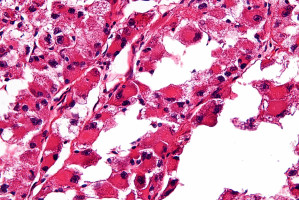
Researchers working to find effective treatments for soft tissue sarcomas have discovered that combining a new anti-cancer drug with an existing one kills cancer cells not only in the laboratory but also in the first two patients treated with it, leading to unusually long-lasting periods without the disease progressing.
Soft tissue sarcomas - cancers of soft tissues such as fat, muscles, blood vessels, nerves, tendons and ligaments - are rare but difficult to treat successfully if they are advanced and have spread to other parts of the body (metastasised).
In a late-breaking presentation at the 28th EORTC-NCI-AACR Symposium on Molecular Targets and Cancer Therapeutics in Munich, Germany, today (Friday), Professor Antoine Italiano, head of the Early Phase Trials and Sarcoma Units at Institut Bergonié, Bordeaux, France, described how a new drug, GDC-0575, inhibits a molecule called Checkpoint kinase 1 (CHK1) that regulates the response of cancer cells to DNA damage.
By inhibiting CHK1, the drug prevents tumour cells recovering from DNA damage and they die. Combining GDC-0575 with gemcitabine, a cancer-killing drug that is already used for treating sarcomas, proved remarkably effective.
"Soft tissue sarcomas represent a rare group of malignant tumours. Despite the use of surgery, radiotherapy and chemotherapy to treat the tumour in the localised region in which it started, up to 40% of patients will develop recurrence with cancer cells spreading to other parts of the body," he said. "The number of drugs approved to manage patients with advanced sarcoma is very low and patients in this setting have a very poor outcome with a median [average] overall survival of only 12-18 months. Gemcitabine is one of the drugs used in patients with advanced soft tissue sarcoma.
"We did this study in order to assess if combining a CHK1 inhibitor with gemcitabine can improve the anti-tumour efficacy in pre-clinical models of the disease. We observed a very strong synergy between the CHK1 inhibitor GDC-0575 and gemcitabine in sarcoma cells in the lab, but also in mice. The combination of the two drugs significantly reduced tumour growth rate in comparison to treatment with just one drug both in the lab and in the mice.
"Interestingly, two patients, who were treated with such a combination in a phase I clinical trial had a meaningful response, which is quite unusual in this setting. Despite a significantly lower dose of gemcitabine than is used routinely, the tumours in these patients shrank rapidly and substantially for an unusually long-lasting time. The first patient who had a leiomyosarcoma with extensive metastases in the peritoneum had a partial response, in which the tumour shrank, that lasted for one year. The second patient, who had lung metastases, had a complete response, in which the cancer completely disappeared, that is still ongoing nine months after the start of treatment."
The patients had been given 250mg/m3 a week of gemcitabine instead of the more usual 660 mg/m3.
Gemcitabine was given intravenously and GDC-0575 was given orally with a range of different doses.
The researchers analysed tumour samples taken from the first patient at the start of treatment and when the cancer started to grow again to identify genes that might play a role in the patient's eventual resistance to the treatment. "We have identified 16 potential genes and these data now have to be validated by further studies," said Prof Italiano.
The study is no longer enrolling new patients but Prof Italiano said "Based on these pre-clinical and preliminary clinical data we will try to set up a phase II clinical trial to assess the safety and efficacy of gemcitabine plus a CHK1 inhibitor in soft-tissue sarcoma."
Chair of the scientific committee for the Symposium, Professor Jean Charles Soria from the Institut Gustave Roussy, commented "Exceptional responders in the clinical setting represent unique opportunities to better understand the biological basis underlying tumour shrinkage. This is very well exemplified in this work, where not only the basis of response is analysed by sequencing all the active genes in the tumour samples, but also the basis of acquired secondary resistance."
Source: 28th EORTC-NCRI-AACR Symposium